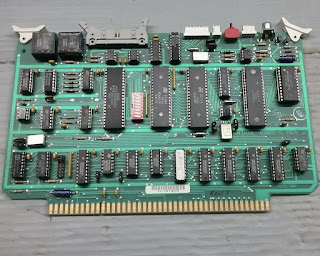I recently procured another EXORbus processor board, the MIKUL 6809-5, for a reasonable price. Let's take a look...
Notable ICs:
- Motorola MC6809 processor
- MC6821 Peripheral Interface Adapter (PIA)
- MC6847 Video Display Generator (VDG)
- Z0844206 SERIAL INPUT/OUTPUT CONTROLLER (SIO/2)
- MM74C923 20 Key Keyboard Encoder
Ports:
- EXORbus card edge
- RS232 and RS485 / multidrop LAN port?
- 20 key matrix keypad
- LED indicator ?
- video output
- composite video
It is interesting that the board uses the MC6809 CPU with a MC6847 VDG like the Radio Shack Color Computer (CoCo). Unike the CoCo, it does not have an MC6883 SAM, making it similar to the Radio Shack TRS-80 MC-10 (which uses an MC6803, rather than the MC6809). So the basic CPU and video chipset places it somewhere between those two computers.
Notably, the board does not have any provision for ROM or application RAM on it. As a result, it needs another memory board on the bus to function properly. The MIKUL 6218 would make a perfect companion for it, but I already modified my 6218 board to work with the my CMS processor boards...whoops. So, with the price of these MIKUL boards dropping due to an apparent glut of them, I picked up a fresh MIKUL 6218 for ~$35 and installed them both in my EXORbus MULTI-PLANE backplane.
Despite the interesting video output, I am not in love with the features. The MC6821 PIA is dedicated to running the keypad encoder and baud rate dip switches, so it can't be used for much. Really the MIKUL 6809-4 or 6809-6 (Motorola MicroModule clone?) would be a better choice as a all-in-one SBC. However, the 6809-5s are definitely more pentiful and far cheaper right now, so maybe somebody else can make use of any info I publish about it.
P2 Serial Ports
Based on the various signal amplifiers and components connected to this port, I initially thought it was only for some sort of industrial multidrop LAN specification, such as RS485. However, connected to the B serial port of the SIO/2 is a basic RS232 connection to pins 15-25. So, port 1 includes multidrop AND RS232, with an unconventional pinout which does not match a standard DB25 IDC cable.
P2 HEADER
______
??? |1 2| GND
??? |3 4| GND
GND |5 6| GND
??? |7 8| GND
??? |9 10| GND
GND |11 12| GND
??? |13 14| GND
GND |15 16| GND
RTS |17 18| GND
Tx |19 20| GND
CTS |21 22| GND
Rx |23 24| GND
DCD |25 26| GND
|______|
P3 Matrix Keypad port
P3 is connected to a MM74C923 20 Key Keyboard Encoder IC, which is connected in turn to a port on the MC6821 PIA. P3 HEADER
___
COL1 |1
ROW1 ||2
COL2 ||3
ROW2 ||4
ROW3 ||5
ROW4 ||6
COL3 ||7
ROW5 ||8
COL4 |9
|___
Unfortunately, this pinout does not match well with standard 20 key matrix keypads, so some wire rearrangement will be necessary to use it.
Boot It Up!
With the MIKUL 6809-5 and the new MIKUL 6218 in place in the backplane, there wasn't much left to do but flip the switch.
After the boot, I shorted pins 1 and 2 of the P3 Matrix keypad port to simulate a keypress, and "CASEMATE" responded!
Since I had another EPROM labeled "TEMPMATE" left over from my first MIKUL 6218, I swapped it in to see what would happen:
 |

|
So both boards seem to be working! It is obviously used as a controller for some sort of industrial furnace/oven. I have also seen MIKUL 6218s with an EEPROM labled "PLCMATE" which I assume is similar to these programs. I ordered a 4x5 keypad which should make navigating the menus a bit easier. Now, I may take a stab at porting Nitros-9 on to it.



No comments:
Post a Comment